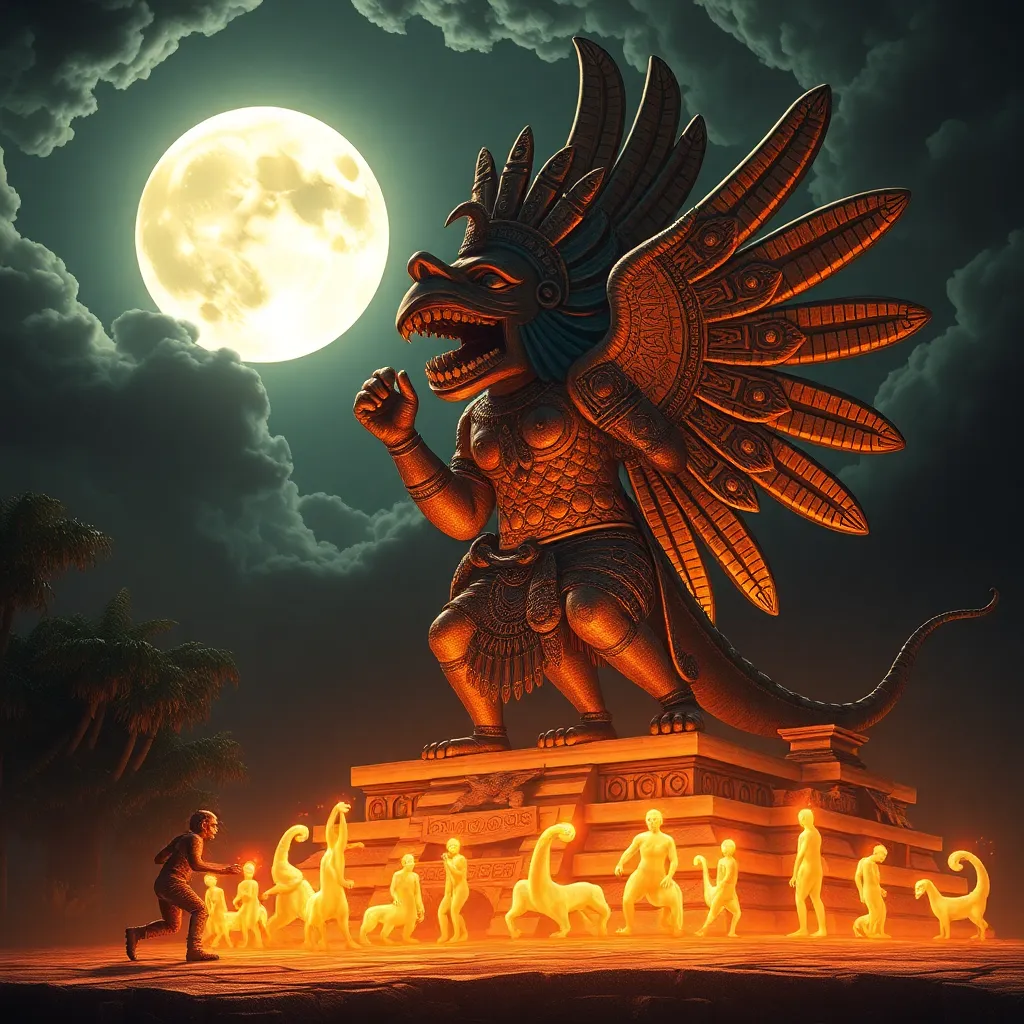Coatlicue and the Birth of the Moon: Celestial Symbolism in Aztec Mythology
I. Introduction
Aztec mythology is a rich tapestry of gods, goddesses, and cosmic events that illustrate the beliefs and values of the Aztec civilization. Central to this mythological framework is Coatlicue, a powerful goddess whose narratives encapsulate the duality of life and death, creation and destruction. Her significance in Aztec culture is profound, particularly as it pertains to celestial symbolism, most notably the birth of the moon.
II. Who is Coatlicue?
Coatlicue, often referred to as the “Serpent Skirt,” embodies a dual nature that reflects the complexities of existence. As a goddess, she represents both fertility and death, nurturing and destruction. Her imagery typically includes a skirt made of serpents, a necklace of human hearts, and a face adorned with skulls, symbolizing her role as a life-giver and a life-taker.
A. The Dual Nature of Coatlicue as a Goddess
This duality is essential to understanding Coatlicue’s character; she is revered as a nurturing mother yet feared as a formidable force of nature. This complexity allows her to embody the balance necessary for the cyclical nature of life.
B. Coatlicue’s Role as the Mother of Gods
Coatlicue is recognized as the mother of several important deities, including Huitzilopochtli, the god of war and the sun, and Coyolxauhqui, the goddess of the moon. Her maternal connections place her at the center of the Aztec pantheon, emphasizing her importance in their cosmological narrative.
C. Historical and Cultural Context of Her Worship
Worship of Coatlicue was integral to Aztec society. Temples were dedicated to her, and rituals often involved offerings that highlighted her nurturing aspects. The reverence for Coatlicue reflects the Aztecs’ understanding of the natural world and their reliance on agricultural cycles, which were deeply connected to celestial movements.
III. The Birth of the Moon: Mythological Narrative
The narrative of Coatlicue’s connection to the moon is both captivating and rich in symbolism. According to Aztec mythology, Coatlicue became pregnant after she found a ball of feathers that fell from the sky. This miraculous conception led to the birth of the moon, represented by her daughter, Coyolxauhqui.
A. The Story of Coatlicue and the Moon’s Birth
In the tale, Coyolxauhqui, initially angry and jealous of her mother, plotted against Coatlicue. However, Huitzilopochtli, who was born fully grown and armed, defended his mother and defeated Coyolxauhqui. This conflict symbolizes the struggles inherent in the cycle of life, where creation often arises from chaos.
B. Key Characters and Their Roles in the Narrative
- Coatlicue: The mother goddess, representing fertility and the earth.
- Coyolxauhqui: The moon goddess, signifying femininity and the complexities of sibling rivalry.
- Huitzilopochtli: The sun and war god, exemplifying the protective aspect of maternal love.
C. Symbolic Significance of the Moon in Aztec Beliefs
In Aztec cosmology, the moon is associated with femininity, cycles, and fertility. The moon’s phases were linked to agricultural practices and the rhythms of life. Thus, Coyolxauhqui’s narrative is not just a story of conflict but also an allegory for the natural cycles that govern existence.
IV. Celestial Symbolism in Aztec Mythology
Celestial elements play a crucial role in Aztec cosmology, influencing their understanding of time, agriculture, and spirituality. The sun, moon, and stars were not merely astronomical bodies; they were intertwined with the lives of the people.
A. Overview of Celestial Elements in Aztec Cosmology
In Aztec mythology, celestial bodies were personified as gods and goddesses. The sun was seen as a powerful force, while the moon represented a more nurturing and cyclical aspect of life.
B. The Moon and Its Associations with Femininity and Fertility
The moon, governed by Coyolxauhqui, symbolizes the feminine principle. Its phases mirror the menstrual cycle, reinforcing the connection between the moon and fertility.
C. The Relationship Between Coatlicue and Other Celestial Bodies
Coatlicue’s relationship with other celestial bodies is pivotal. She is often depicted as a mother figure, emphasizing the nurturing aspects of the cosmos. Her connection to both Huitzilopochtli and Coyolxauhqui illustrates the balance between creation and destruction.
V. The Symbolism of Coatlicue’s Imagery
A. Iconography Associated with Coatlicue
Coatlicue’s imagery is rich with symbolism. Her serpent skirt represents the earth and the cyclical nature of life, while the skulls and hearts signify the constant presence of death and sacrifice.
B. Analysis of Her Representations in Art and Sculpture
Artistic representations of Coatlicue often highlight her fierce and maternal aspects. Sculptures and carvings depict her in various forms, each emphasizing her duality and connection to the earth and cosmos.
C. The Significance of Her Visual Elements in Relation to the Cosmos
The visual elements associated with Coatlicue serve as reminders of the interconnectedness of life, death, and celestial events. They illustrate how the Aztecs viewed the universe as a dynamic and living entity, where gods and celestial bodies interacted with human existence.
VI. Coatlicue’s Legacy in Aztec Religion
A. The Role of Coatlicue in Rituals and Ceremonies
Coatlicue’s influence extended to various rituals and ceremonies, where she was honored as a life-giver. Offerings and sacrifices were made to appease her, seeking her blessings for fertility and harvest.
B. Her Influence on Later Mesoamerican Cultures
The legacy of Coatlicue transcended the Aztec civilization, influencing later Mesoamerican cultures. Her themes of motherhood, fertility, and celestial connections persisted in various forms across different societies.
C. Modern Interpretations and Relevance of Her Myth
Today, Coatlicue’s story resonates with contemporary themes of femininity and environmental interconnectedness. Her narrative serves as a vital reminder of the balance between creation and destruction and the importance of nurturing life.
VII. Comparative Analysis with Other Mythologies
A. Similarities Between Coatlicue and Other Mother Goddesses
Coatlicue shares similarities with other mother goddesses across various cultures, such as Gaia from Greek mythology and Durga from Hindu tradition. Each of these figures embodies the duality of creation and destruction.
B. The Moon’s Representation in Different Cultures
The moon is often associated with femininity and fertility in many cultures. For instance, in Roman mythology, Luna represents the moon, embodying similar characteristics as Coyolxauhqui.
C. The Universal Themes of Birth and Creation in Mythology
Across cultures, the themes of birth and creation are prevalent. These narratives reflect humanity’s understanding of the life cycle and the profound connection between the cosmos and human existence.
VIII. Conclusion
Coatlicue’s significance in Aztec mythology is a testament to the rich narrative traditions that shaped the civilization’s understanding of the cosmos. Her story, intertwined with the birth of the moon, offers profound insights into the celestial symbolism that permeated Aztec culture. The enduring impact of her narrative continues to resonate today, highlighting the importance of preserving these mythological stories that connect us to the past and the universe.



